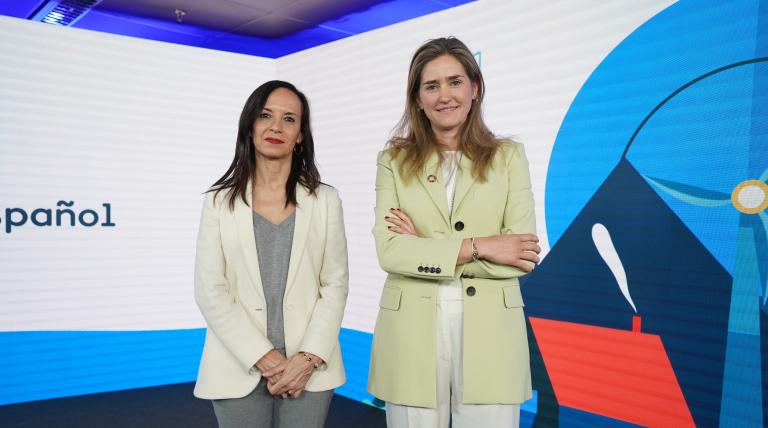For 40 years, we've been driving our country's economic and social progress. Four decades shaping Spain.
Renewable energy could account for 50% of Spain's electricity generation mix in 2023
- In 2022, 5.9 GW of newly installed renewable power capacity has been added, which has enabled records for wind and solar photovoltaic production to be set.
- Spain was the second European country, after Germany, in terms of installed renewable power capacity.
- For the first time since 2015, this renewable energy potential in Spain has enabled the energy exchange balance, especially with France and Portugal, to close the year with an export balance.
2023 will be a key year for the green transition in Spain: according to Red Eléctrica's estimates, renewable energy could reach 50% of the annual electricity generation. These preliminary figures, which are still subject to a high degree of uncertainty, predict that the contribution of wind and solar power could reach 42%. This was made clear by the Secretary of State for Energy, Sara Aagesen, and the Chairwoman of Redeia, Beatriz Corredor, during the presentation of Red Eléctrica's reports for 2022: the Electricity System Report and the Renewable Energy Report.
At the event, the Secretary of State for Energy, Sara Aagesen, stressed that "the energy transition is a great opportunity that we must all take advantage of. It has immense benefits for citizens and companies, but it must be done intelligently, taking into consideration both the natural environment and the stakeholders in the territory; we are ready, with our grids and our capacity to help and consolidate solidarity at a European level".
For her part, the Chairwoman of Redeia, Beatriz Corredor, predicted that "2023 will be a great year for the green transition in Spain and a transcendental year for us to consolidate our position as the driver of renewable energy in the European Union". The Chairwoman highlighted the critical role of the transmission grid in this energy transformation process in Spain: "without a grid there is no renewable energy and no green transition".
As a new innovative measure, this year the Company is offering these publications fully digitised and three months earlier than usual. They can now be consulted on the Company’s website through a space specifically designed to offer a more accessible and interactive browsing experience. Users can select the energy technology of interest and the desired magnitude (power capacity, generation, demand, etc.) and, also find international comparisons.
Driving renewable energy in the EU
Both reports show that in 2022 Spain continued to demonstrate its leadership in renewable energy in the European Union. It is second only to Germany in terms of installed renewable power capacity and also in terms of installed wind power capacity. In the case of solar power, Spain is the third country with the most capacity in service after Germany and the Netherlands.
If we analyse the generation obtained from these technologies, Germany maintains its first position in the ranking and Spain is the second European country that produces the most energy from wind and the sun.
This enabled Spain to support its EU neighbours in 2022, as indicated in the Electricity System Report. For the first time since 2015, the year closed with an export balance, a figure that stood at almost 20 TWh, which is the highest value ever recorded.
A boost for wind and solar photovoltaic
Last year, renewables added 5.9 new GW to the Spanish power generation fleet. Of these, 4.5 GW were solar photovoltaic, and 1.4 GW were wind. This fact confirms the spectacular evolution of solar photovoltaic energy: it was the year that saw the greatest growth in installed power capacity, enabling it to overtake hydroelectric power and become the third source in the generation structure. For its part, wind power remains the leading renewable technology: already 1 out of every 4 MW in service in Spain is wind power.
This new momentum has enabled wind to account for 22% of the generation mix and solar photovoltaic for 10%, with both technologies registering record production. In total, renewables accounted for 42% of the overall generation mix in 2022. The drop in hydro production of almost 40% has prevented the share of renewables from surpassing previous records.
Other magnitudes
In the Electricity System Report, Red Eléctrica analyses the evolution of other magnitudes such as electricity consumption, emissions, and electricity markets, among other things.
Specifically, this document highlights that electricity demand in Spain during 2022 showed a decrease of 2.4% compared to the previous year, with demand reaching 250.4 TWh. After having factored in the effects of seasonal and working patterns, the decrease stands at 3.3%.
The Report also confirms that last year was a warmer winter and hotter summer than usual. In fact, the maximum peninsular demand was recorded during the summer season, when it totalled 38,003 MWh on 14 July at 3:00 p.m., something that had not occurred since 2016.
Red Eléctrica's publication also devotes a chapter to the analysis of the transmission grid, which in 2022 reached more than 45,100 km of line circuit, and had a grid availability rate of 98% nation-wide, thus demonstrating the resilience of the elements that comprise it. Last year, Red Eléctrica promoted the development and strengthening of the grid, with the commissioning of strategic projects such as the Caparacena-Baza electricity axis or the Lanzarote-Fuerteventura submarine link and with significant progress having been made in others such as the Ibiza-Formentera subsea link or the interconnection with France across the Bay of Biscay. The Company is also making progress on the Salto de Chira hydro power station in Gran Canaria, the first major energy storage system in the Canary Islands.
Click here to read the full report
<p>
Selecciona la CC AA que deseas y consulta la nota de prensa
</p>
















